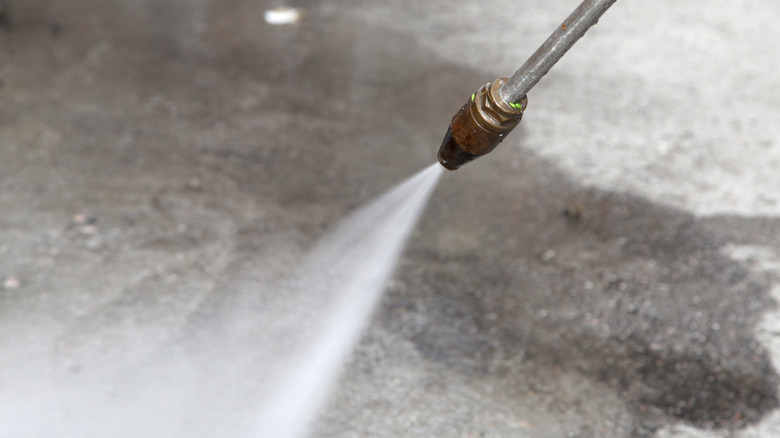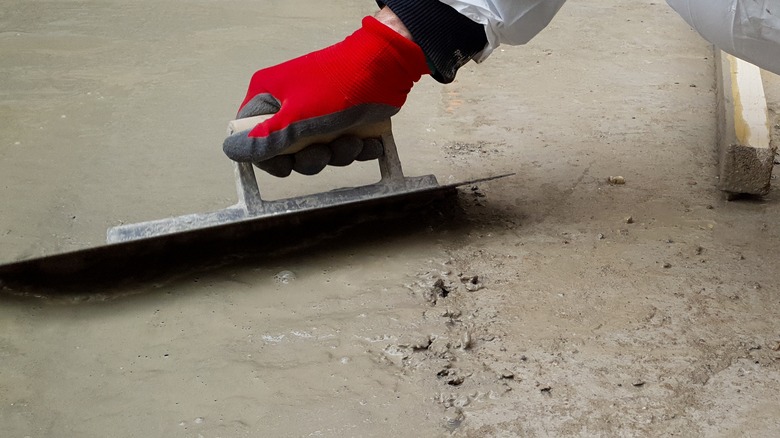Fix Concrete Patio Cracks By Taking These Essential Steps
We may receive a commission on purchases made from links.
Are you finding cracks in your patio's concrete deck? The sight may be unnerving, and you may well think that there's a major issue causing the damage — one that will take lots of time and money to resolve. Well, you'll be happy to know that cracks are an entirely natural occurrence in concrete, and most of them are quite harmless. Small concrete cracks may happen because the concrete mix dries too quickly while curing, due to exposure to repeated freeze and thaw cycles, or simply due to wear from the foot traffic. Larger cracks may be caused by more serious problems, such as the grade settling or large tree roots pushing the soil and the concrete upwards. Fortunately, you can fix narrow cracks (and some wide ones) quite easily by filling them in with a suitable compound.
Before you start, you'll need to equip yourself with the right gear, including rubber gloves, safety goggles, a putty knife or trowel, a pressure washer, and some brushes and cloths. You'll also have to either mix or buy the filler material; the type you choose depends on the type of crack you're fixing. The process itself then boils down to placing the filler into the crack. Below, we'll walk you through the nuances of using filler to repair cracks so your concrete patio can look stunning again.
Steps for repairing narrow cracks in concrete
Narrow concrete cracks — those measuring less than ¼-inch in width — are usually easy to handle. Start by preparing the concrete for the job. First, clean your concrete patio, paying particular attention to the cracks and the surface around them to ensure there's no debris left. You may need to chisel away bits of concrete that are coming loose around the crack, too. Then, you'll need to pressure-wash the area thoroughly with water. This step gets rid of any dirt your brush can't pick up, along with any fungus or algae that may be growing there.
Next, prepare the filler to put inside the cracks. You can make the filler by mixing water and Portland cement until the mix assumes a paste-like consistency. If you're using this filler option, apply it to the cracks while the concrete is still moist after washing. This way, the concrete does not pull the moisture out of the grout, which could prevent the mix from curing properly inside the crack. Place as much grout as the crack can accommodate, then spread the excess around the surface with a trowel or putty knife. In the end, the surface should be nice and smooth with no sign of the crack left. Let the filler dry for two hours, then cover it with a tarp or board for five days, sprinkling the filler daily with water to help the curing process. Alternatively, you can use a concrete crack filler like this one from Lowe's, then let it dry per the manufacturer's instructions.
How to repair wide cracks in a concrete patio
You should be able to fix cracks that are between ¼ and ½-inch wide using a concrete backer rod along with filler. A backer rod is a foam rod that helps fill the crack so you can use less filler (you can find them at Home Depot). Start by undercutting the cracks with a chisel and sledgehammer — this practice makes the bottom portion of the crack wider than the top, which helps keep the filler in place. Next, remove any debris from the crack, give the area a good pressure wash, and then dry it and give it a final cleaning with a shop vacuum. Now, you can lay the back rod into the crack and fill it with the concrete patching mix, smooth it out with a trowel or knife, then let the mix cure per the directions on the product's label.
If the cracks are larger than ½-inch, you should engage a professional to learn why they're occurring in the first place. Even ¼-inch cracks can be caused by serious issues, such as erosion, or soil movements due to improper compaction. Cracks that are wider and deeper generally point to underlying issues that you must resolve before making any aesthetic repairs. For example, you may have a tree with a large root system that's upheaving the soil and causing the damage you're seeing on your concrete deck. A professional will help you diagnose the problem and give expert recommendations for repairing the concrete cracks.


